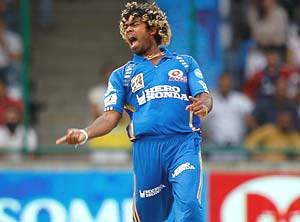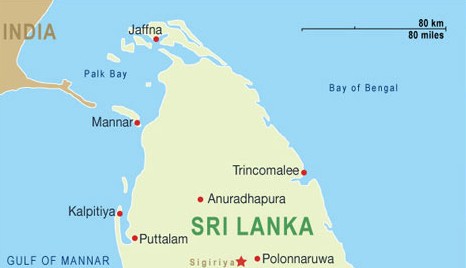 One of the most sought-after players in T20 cricket, having earned a reputation for his toecrushing yorkers and trademark bleach-blonde locks, Lasith Malinga has built a cult following, starting from Sri Lanka stretching to Mumbai and spanning the globe.
One of the most sought-after players in T20 cricket, having earned a reputation for his toecrushing yorkers and trademark bleach-blonde locks, Lasith Malinga has built a cult following, starting from Sri Lanka stretching to Mumbai and spanning the globe.
In an almost decade-old international career, Malinga has earned many names – ‘Hero’ for the countless times he has helped his team with the ball (and the bat on a few occasions, most notable – Melbourne in 2010) and picked up hat-tricks; ‘Villain’ for his predictability and ineffectiveness against the country’s now most fiercest rivals, India; ‘Mercenary’ for his supposed priority to play in the IPL over his country; and even ‘Sex-Symbol’, having been voted the ‘The Sexiest Man In Cricket’ during the 2007 World Cup in the West Indies.
In an exclusive interview with ‘Daily Mirror’, Malinga reveals his joy of playing cricket, the passion – contrary to popular belief – he has been representing his country, also elaborating on his much talked about and equally criticised retirement from Test cricket, and impending retirement from International cricket, calling on the younger generation to learn from his bowling and not sense of style.
- What are your views about the Sri Lanka Premier League (SLPL)?
I think it’s a very good tournament, because it’s a good opportunity for Sri Lankan players to perform and be selected for the upcoming World T20. It is also a great opportunity for players in the (national) team to get match practice and gives amateur players, who haven’t been recognised internationally, the chance to showcase their talents on a big stage and impress the selectors. The SLPL is also a good platform to build a strong national team, ‘A’ team and development squads with the talent that is available.
- You are captaining the Ruhunu Royals franchise. What difference do you see between ‘Malinga the player’ and ‘Malinga the captain’?
This is the first time that I’m captaining a team so it is a challenge. But I have some experienced players in the team like Chamara Silva, Shahid Afridi, and a few Australian players, and I get a lot of support from them. As a captain, I have no great burden because all the players have played at the highest levels in their countries and they are aware of what is required of them. So I just have to ensure I make the right bowling changes and have their mindsets ready. I think that is the biggest responsibility. I have played for close to a decade now and I have a grasp of getting these players mentally prepared in order to get the maximum out of them.
- You have received a lot of criticism regarding your commitment to Sri Lankan cricket. Many have alleged that you give more priority to the IPL. How do you respond to that?
I’ve heard many people say this, but that’s how they look at things. I personally believe they haven’t seen what I have done for this country. For example, many people have accused me of taking wickets at the IPL and not when I’m playing for the country.
I love playing in the IPL and I take a lot of pleasure playing in it. But, I have also taken the highest amount of wickets (in ODIs) in the world during the past two years. Last year I took 48 wickets and Shahid Afridi was second with 45 (in ODIs).
Even this year I’ve taken a good amount of wickets for Sri Lanka. I don’t know what people see (when they say this) but as a player I have done my duty for our team. I don’t like to talk about it but I know that there are a lot of things that I have done. I am the only player to have taken three hattricks in One Day International cricket. However, if I fail to take wickets during a match a lot of people have things to say. But I give my hundred per cent every time I play for the country.
- Why did you retire from test cricket?
I retired from Test cricket in 2008 after I suffered a leg injury. After the injury I was not given a contract, even though I was injured while playing for my country. I felt very sad when I thought about it; that despite me playing for my country and injuring myself, they did this to me. This was one of the many questions that were there in my head at the time. I had no problem financially but it hurt a lot.
I couldn’t play test cricket for two and half years and then I made a comeback. This was the series in which Muttiah Muralitharan was retiring. He is a person I have a lot of respect for and he asked me to play, so I agreed. I was happy that the match was played in Galle in which I got 7 wickets and scored 67 runs and was awarded the man of the match.
During those two and a half years where I didn’t play, no one even bothered to know what happened to Lasith Malinga. I think it was only after I played that match that people started to inquire about me. After I played that match it took me about 3 to 4 months for the pain on my legs to recede, so I thought that if I continue to play test cricket I wouldn’t be able to play for Sri Lanka for a long time. Because of that I decided that I would retire from tests and play 50-over and T20 cricket so I could prolong playing for my country.
- Why do you think this happened to you at the time?
The chairman of the committee at the time was Mr. Arjuna Ranatunga and I can’t really think of why they treated me that way. At that point I knew that at the end of the day I will have to look after myself and no one would be on my side. I knew that if I take wickets I’ll be in the team and if I don’t, I won’t be. I don’t want to be in the team without performing anyway. In every match I try to take the maximum number of wickets and that is what I’m always focused on.
- Why do you think they treated you that way?
I don’t know for sure but a similar incident happened to Prabath Nissanka. He had to give up playing cricket after he suffered an injury similar to mine. So I think the authorities at the time thought that there is no use of having me and that it was the end for me.
The injury I suffered was very serious which very few people had suffered from. Dr. David Young told me that I could only hope (to recover) and that it could be career ending.
I think the authorities thought I would also face the same fate as Prabath and they must have thought that paying for me and for my treatment was a waste of money. They would’ve thought that the money would be better utilised if it’s used on another up and coming player. Their decision might be justified but my main grievance is that this happened to me while I was playing for the national team.
- After all this you came back to the team and you have performed exceedingly well. What was it that motivated you?
After I recovered from my injury I got an opportunity to play in the second edition of the IPL (for the Mumbai Indians), where I had to bowl only four overs. I did well, after which I was included in the World Cup team. I had a lot of mental strength to perform; people like Champaka Ramanayake who was a coach, looked after me after I was discovered. He motivated me and kept advising me. He always encouraged me to bowl fast and accurately.
So I always had in mind that if I recovered I’ll bowl better. I never ever thought that I could have reached the level that I have reached now, but I knew that I would get a chance someday if I performed well in domestic matches. And that’s how it all came about. I practiced well and I think this is what led to my resurgence.
- Will we ever see Lasith Malinga play test cricket again?
No, I don’t think I’ll ever play Test cricket again. I’ve taken 100 wickets in 30 test matches and if I am to play again I have to take another 50 or 100 wickets, which I can’t do, given my situation.
I’m 29 now and I think it’s best for a youngster to get that experience, instead of me playing.
People have told me to play one test match per series but I don’t like to play like that. If I’m playing I want to give my fullest to my country. I know a lot of people think otherwise, but I don’t like to bowl 12 over per match and sit down. If I’m playing I have to be willing to bowl whatever is required even if its 40 overs. I can’t do that given the injury, so I don’t think I’ll ever play test cricket again.
- There were some issues regarding your contract with the SLC. Tell us about it?
It was only last year that I couldn’t sign a contract and that was because I received the contract about six months later than the date I should have received it. There were some issues with it and when we were working to rectify the issues, SLC was dissolved and they called for elections.
When I spoke to the heads they told me that we should talk about this after the elections and when the elections were over it was January and the contract was set to expire in March. So I decided against signing a contract for the last year and instead signed one this year.
- Is playing for Sri Lanka your first priority?
Most definitely. I obviously like to play in other leagues but if there is ever a T20 match or an ODI for Sri Lanka I would willing leave everything else and play for my country.
- Who are the most difficult batsmen you have bowled to?
Initially I found it difficult to bowl to Brendon McCullum. In Sri Lanka, players like Thilan Samaraweera, Mahela Jayawardene, Kumar Sangakkara, and Sanath Jayasuriya – there’s nothing to say about them because everyone knows how good they are. Of late Virat Kohli has scored runs off my bowling.
When you bowl in a match, situations are different and they change frequently, and different bowlers respond differently. When I bowl I also think about what delivery I can best bowl in a situation and that’s how I choose what to bowl. So I try that, and sometimes it works, sometimes it doesn’t.
- What is the format you enjoy playing the most?
I like all three formats of the game. Test cricket is a format where you can always learn. You have to think about what to bowl in each situation; how to use each delivery; how to bowl with the old ball and the new ball; how to change a batsman’s mentality. You can learn all that from Test cricket.
In One Day cricket it is a little difference. Unlike Test cricket – where you have time to comeback from a bad spell – (in ODIs) you have to do your best in the ten overs you bowl. In T20 cricket you have only four overs.
I think the skill to perform well in ODIs and T20s can be learnt from playing Test cricket. I’m fortunate to have played even 30 Tests in my career. I have learnt how to reserve the ball, how to change the batsman’s mindset – and I have succeeded in the shorter formats – because I played Test cricket.
- What do you think about the current situation of our national team given the fact that we have been losing in the recent past?
I think the team is really good. The last few matches we lost, we lost by close margins and we fought well till the end. But I think, as bowlers we didn’t bowl well enough from start to finish. We bowled well in some instances, and fell back in others.
That is the main reason I feel we lost the last few matches.
- Will you be playing cricket in five years?
I won’t be playing international cricket in five years. My ambition is to play for two or three more years because I know there are enough and more better cricketers to play after me.
However, I would like to teach what I know and what I have learnt to anyone willing to learn.
- What are your cricketing goals?
I don’t have any big goals like that. I have enjoyed the time I have spent playing cricket. My only aim is, if I get a game in the next series, to play to the best of my ability.
If I have big ambitions I might be scared to put my full effort for the fear of getting injured. So I have no goals like that in mind. I just want to play, even if I get injured, and then when the time is right, move away. I am very happy playing like that, putting in my 100 per cent without thinking about future games.
- It is apparent that you have not lost your grassroots. How do you keep that same stature now that you are an international star?
I’m from Rathgama, Galle and I was first introduced to cricket by playing soft-ball cricket with my friends. I can bowl well today I think, because I played soft-ball cricket. I do that to this day with my friends. Nothing needs to change just because I play for the national team.
- So you still have the same friends?
Well some of them still keep in touch with me. Some have gone away for work and there are a few who think that I have changed because I don’t go to my village as often. That’s the way different people think and you can’t change that but I will continue to be the same.
- What is the next hairstyle that we can expect?
I don’t think there be will any change, until the end of my career at least. I don’t think it’s a problem to anyone.
However I appeal that no one should follow me because of my style or behaviour, it should only be how I play cricket. I want children, as well as adults, to understand that.
Source: Daily Mirror (Sri Lanka)







